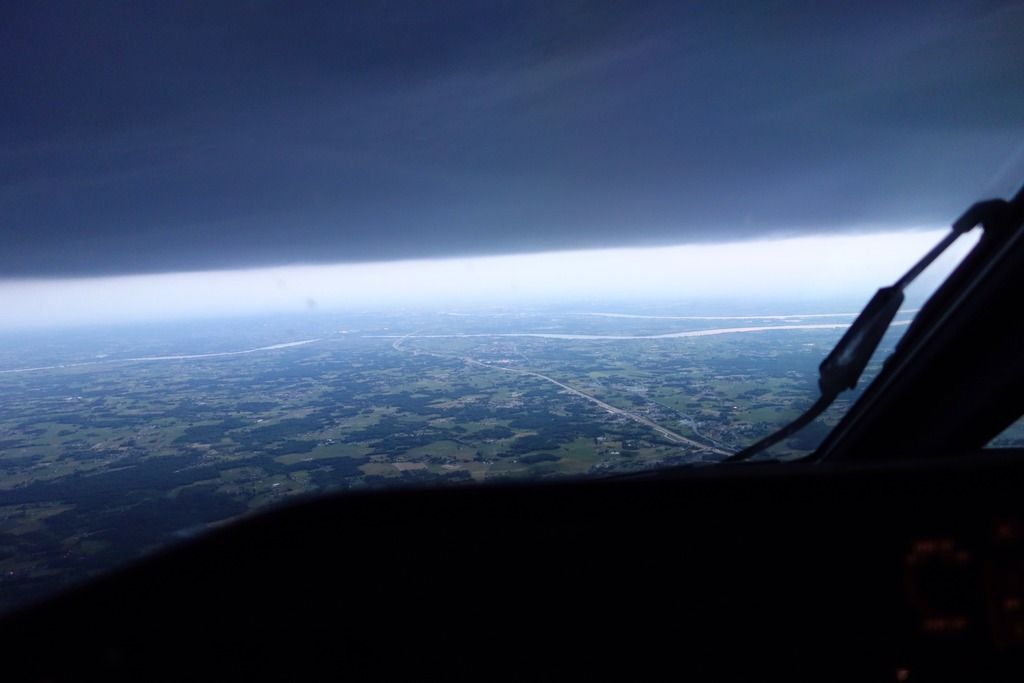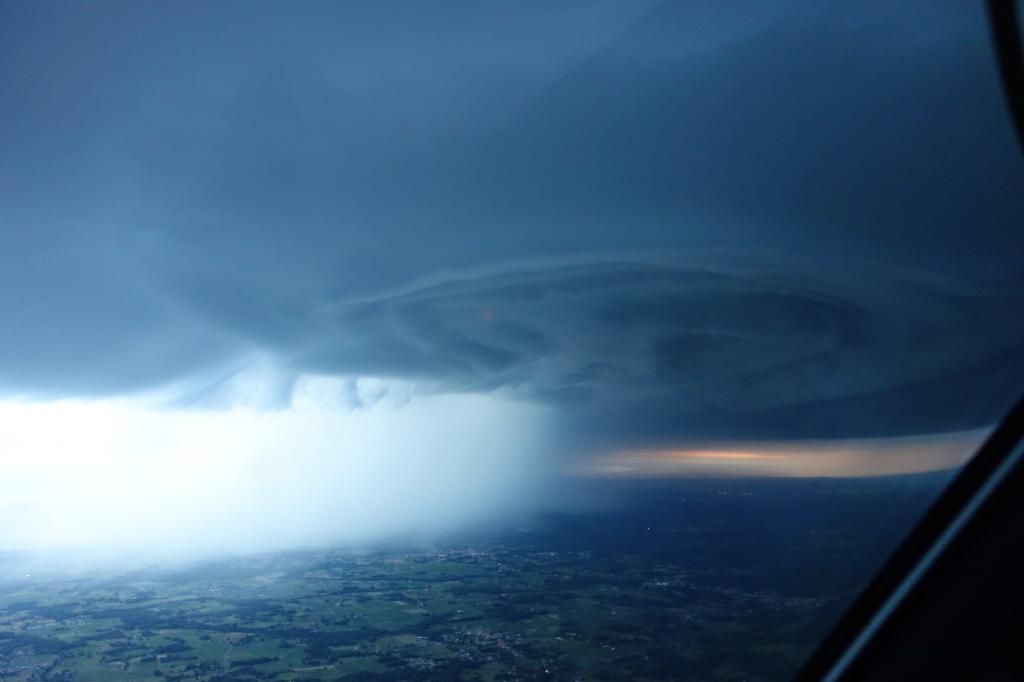Windshear and proximity to CBs
Thread Starter
Join Date: Jun 2000
Location: Gloster,UK
Posts: 75
Likes: 0
Received 0 Likes
on
0 Posts
Windshear and proximity to CBs
As PPLs we have been taught never to go closer than 10 nm to an active CB cloud, due to the potentially fatal windshear. This can easily affect large aircraft as much as small ones. For this reason I avoid them like the plague. I don't want to learn the hard way.
This week I was a passenger in an A320/A319 into Paris, and could clearly see a big cumulus dropping a full column of rain, slap bang on the centre line of the approach, at the outer marker. Everywhere else was VMC. Why oh why didn't the Captain take a shorter final and go visual? I don't know.
As it happened, I ***t myself waiting for the massive turbulence and windshear as the plane went under and into the cloud base, right next to the column of rain. I strapped down tightly and waited.
Then...
What happened next surprised me. Absolutely Nothing.
Can someone please explain?
This week I was a passenger in an A320/A319 into Paris, and could clearly see a big cumulus dropping a full column of rain, slap bang on the centre line of the approach, at the outer marker. Everywhere else was VMC. Why oh why didn't the Captain take a shorter final and go visual? I don't know.
As it happened, I ***t myself waiting for the massive turbulence and windshear as the plane went under and into the cloud base, right next to the column of rain. I strapped down tightly and waited.
Then...
What happened next surprised me. Absolutely Nothing.
Can someone please explain?
never to go closer than 10 nm to an active CB cloud
Thread Starter
Join Date: Jun 2000
Location: Gloster,UK
Posts: 75
Likes: 0
Received 0 Likes
on
0 Posts
A "towering Cu that will rain itself out".
Not a phrase that I'm particularly familiar with, but I do understand what you're on about. The tops of these particular clouds on the day did not reach up to the anvil level.
I still wouldn't like to fly a light aircraft through or near to them, and now allocate a dollop of faith in the rain radar that these A320 types carry on board. They have the ability to just miss the worst bit.
Not a phrase that I'm particularly familiar with, but I do understand what you're on about. The tops of these particular clouds on the day did not reach up to the anvil level.
I still wouldn't like to fly a light aircraft through or near to them, and now allocate a dollop of faith in the rain radar that these A320 types carry on board. They have the ability to just miss the worst bit.
Join Date: Jun 2002
Location: Wor Yerm
Age: 68
Posts: 4
Likes: 0
Received 0 Likes
on
0 Posts
Not all CBs are rough, even if they are developing. This one was encountered on the way into Bordeaux. From the outset, you could see from its shape, including a concave base and total lack of rainfall in our direction that our path would be smooth. And it was.



It was scary to look at, but safe in my opinion. However, about 30 minutes after landing it was no longer a friendly giant. It was one of the most incredibly violent thunderstorms I've ever witnessed and would certainly not have flown through it.
So thunderstorms are not always bad, but unless you know for sure it's wise to give them a wide berth. The distance, both horizontally and vertically, varies between time of year, the shape and type of activity of the storm and its vertical ascent and last but not least, its picture on the radar.
PM



It was scary to look at, but safe in my opinion. However, about 30 minutes after landing it was no longer a friendly giant. It was one of the most incredibly violent thunderstorms I've ever witnessed and would certainly not have flown through it.
So thunderstorms are not always bad, but unless you know for sure it's wise to give them a wide berth. The distance, both horizontally and vertically, varies between time of year, the shape and type of activity of the storm and its vertical ascent and last but not least, its picture on the radar.
PM
Last edited by Piltdown Man; 3rd Apr 2016 at 22:56. Reason: Cwap witing, agin
In the original case I would imagine that aircraft in front were reporting a smooth ride and nothing red showing on radar. If it has developed rapidly in the 2-3 mins between flights a windsheer warning would sound and a go-around initiated.
Join Date: Dec 2011
Location: Cambridge
Posts: 913
Likes: 0
Received 0 Likes
on
0 Posts
Yesterday I was flying IFR from Prestwick to Cambridge, a route I have flown frequently. I was given vectors by London that took me a quite a bit south of the point at which I usually get "Direct CAM". Whether by coincidence or not, the vectors skirted perfectly around a CB that would have been in my way.
Does anyone know if London control have weather radar and, if so, do they normally route traffic in this way?
Does anyone know if London control have weather radar and, if so, do they normally route traffic in this way?
Join Date: Feb 2005
Location: flyover country USA
Age: 82
Posts: 4,579
Likes: 0
Received 0 Likes
on
0 Posts
From a prior millenium:
Strictly VFR in a 65hp 7AC Champ, a summer pilotage along a familiar route, I noted a CB probably 10 NM off my right wing. No problem, so I thought. But as I focused on the wx, I became aware that the houses and cows seemed to be getting smaller. I had gradually climbed 800' or so in a few minutes. So I throttled back a little on the way.
But a minute later I noticed I was still climbing. Still out in the clear; I pulled carb heat and throttled back some more. STILL CLIMBING, even at idle!
Not looking to set a new sailplane record, I made a prompt 180 to escape the updraft, and adjusted my route to grant more respect to the storm.

Strictly VFR in a 65hp 7AC Champ, a summer pilotage along a familiar route, I noted a CB probably 10 NM off my right wing. No problem, so I thought. But as I focused on the wx, I became aware that the houses and cows seemed to be getting smaller. I had gradually climbed 800' or so in a few minutes. So I throttled back a little on the way.
But a minute later I noticed I was still climbing. Still out in the clear; I pulled carb heat and throttled back some more. STILL CLIMBING, even at idle!
Not looking to set a new sailplane record, I made a prompt 180 to escape the updraft, and adjusted my route to grant more respect to the storm.

Join Date: Jun 2008
Location: England & Scotland
Age: 63
Posts: 1,413
Likes: 0
Received 0 Likes
on
0 Posts
My instructor related the following when I tried to give (my estimate of) a 10nm gap to an active CB in an R44.
Helicopter (B206) - 1500 ft, with 10nm separation from CB - begin uncommanded climb.
Reduce collective - climb rate increasing.
Lever to the floor - still climbing, and rotor RPM increasing, so have to increase the lever and climb rate
About face, exited the updraft several thousand feet higher
This chap has over 10k hours in helicopters and he would not go within 12 NM of one
Helicopter (B206) - 1500 ft, with 10nm separation from CB - begin uncommanded climb.
Reduce collective - climb rate increasing.
Lever to the floor - still climbing, and rotor RPM increasing, so have to increase the lever and climb rate
About face, exited the updraft several thousand feet higher
This chap has over 10k hours in helicopters and he would not go within 12 NM of one
As PPLs we have been taught never to go closer than 10 nm to an active CB cloud
Personally unless they look very bad I just try to not actually go through them. In my experience the average UK storm is not very dangerous ... of course there are non average ones.
I have met some more interesting CBs in West Africa and USA .... I definitely would not want to get inside them .... but even they have to be very big to make me keep 10 miles away.
Just my personal take ... maybe I have just been lucky.




